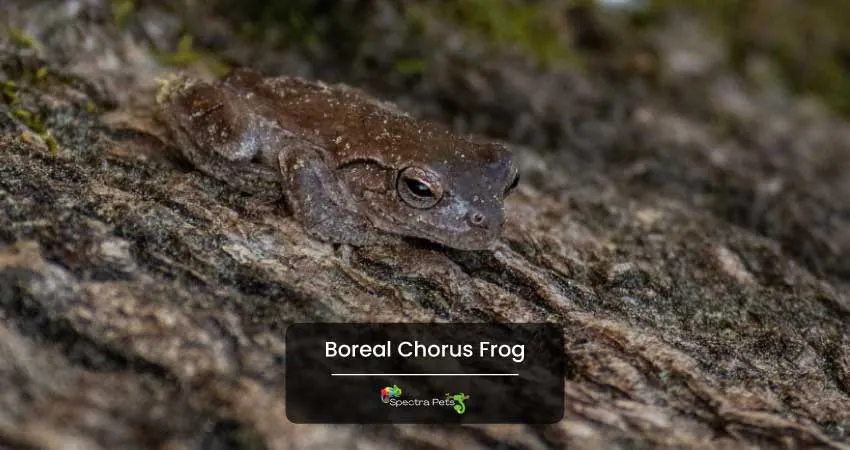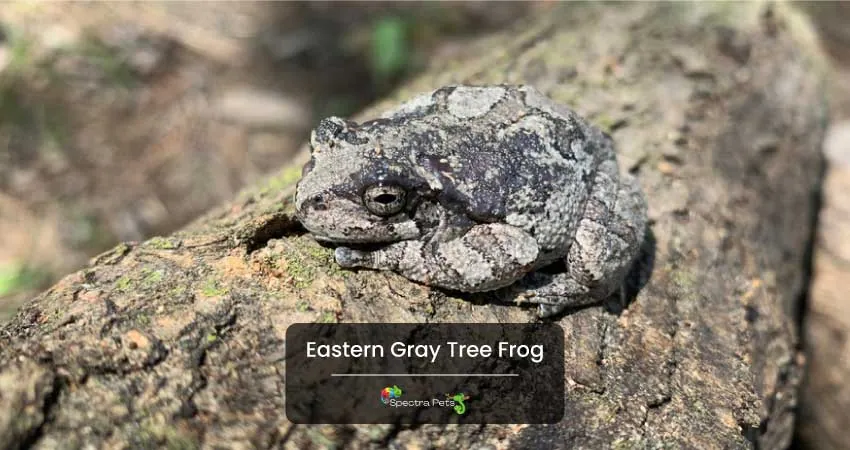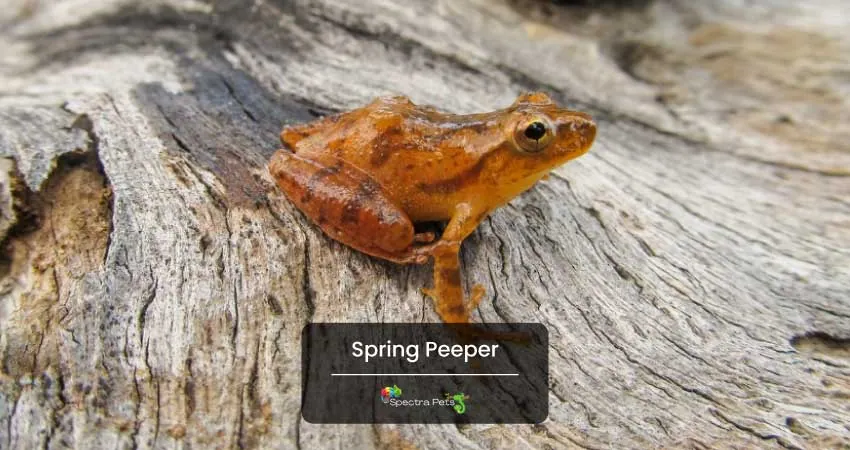Though the number of species of Tree frogs in Vermont is only 3, they have a direct impact on the ecosystem.
Apart from the magnificence of the mountains, Vermont is home to some charming tree frogs, especially the Spring peeper, Eastern gray tree frog, and Boreal chorus frog.
Here, I will show the way these frogs call their mate, the body size, distribution, skin color, breeding season, lifespan, etc. Let’s dive into the frog’s details without further ado!
Boreal chorus frog

Despite the small size and threat by many predators, the distribution of the Boreal chorus frog is rich in different regions in the USA. Which includes states like Vermont, Minnesota, Utah, Montana, Wisconsin, Arizona, and New Mexico.
In terms of skin color, they are found in grey, brown, green, olive, red, and tan colors. Stripes with brown, gray, red, or black are visible on their backside. The size of these Hylidae members can vary from 0.75 – 1.5’’.
This amphibian does not move a lot and migrates hardly around 250 meters. It’s rare for this species to move more than 700 meters from its original birthplace or its parent’s breeding spot.
When it comes to natural habitat, they live close to woodland ponds, grassland, shrubland, etc. During the water’s cold, these little fellas go for hibernation under rocks, underground, below thick vegetation, or under tree logs.
Due to their nocturnal behavior, they start breeding activity from night to dawn. The breeding season of this tiny frog remains from late March – the beginning of June.
The Female appears in the breeding spot to join the male right after the male makes the call. Temporary ponds, flooded fields, swamps, and small lakes are their desirable breeding spot.
Regarding toxicity, they are not toxic at all, so they dodge their predator by swimming or hiding under leaf litter or bark. Their excellent climbing skill also helps them to evade predators.
Plus, the major difference between a male & female is the size where the female is bigger. Along with that, the male has a green or yellow color loose-skin throat. While the female’s throat is cream-colored.
Moreover, the state of Vermont has 1000-4393 feet elevation from the sea level, making it a suitable place for these amazing frogs. As their comfortable elevation level is 3500-12,000 feet. With higher elevations, these frogs get bigger.
Furthermore, the average lifespan of a Boreal chorus frog is less than 2 years though some can live more than 3 years. These wonderful creatures make their living by feeding on spiders, earthworms, flies, mites, and ants which provide great support to the ecosystem of Minnesota.
Eastern gray tree frog

Eastern gray tree frogs can grow from 1.25 to 2 inches in length, while females can reach 1.5 to 2.25 inches. Their webbed foot & hand can generate sticky fluid that helps to climb the trees with less effort.
Plus, this species is found in a wide range of areas, including Vermont, Florida, Texas, Maine, Ohio, Alabama, Tennessee, etc. Their favorite habitat includes woodland forests, agricultural land, and swamps close to water. These tiny buddies just love moisture-loaded zones.
Due to their arboreal nature, they rest a lot on trees and enjoy moths, grasshoppers, ants, beetles, tree cricket, plant lice, snails, etc. Even if they see any smaller frog in front of them they won’t miss the chance to eat that.
Moreover, they choose semi-permanent water bodies, weedy ponds, standing water, and shrubs close to streams or corners of any lakes as breeding spots. As soon as they become 2 years old, they engage in sexual activity in the closest April month. Mating season can last up to August.
With their loud distinctive call, the male gray tree frog attracts the female. During the breeding season, the male becomes surprisingly aggressive. They will fight over the female and their territory. After the successful mating, the mommy frog lays around 2000 eggs on the water.
Compared to other Hylidae members, these amphibians enjoy 7-9 years on average in their natural habitat. The skin color of this frog can vary from gray to brown. And they appear with dark color during the day while at night their skin color becomes lighter.
Spring peeper

This small-size tree frog’s range is also pretty wide in the USA. They are present in Vermont, Florida, Texas, Pennsylvania, Oklahoma, Alabama, Wisconsin, and Michigan.
When it comes to diet, it’s made of flies, spiders, beetles, ants, etc. An adult species will hunt the insects in either the late afternoon or just before the evening. However, the young ones search for their food from morning to afternoon.
Though their predator list is pretty long, they do survive long due to their ultimate jumping skill. Their predator is snakes, large spiders, birds of prey, raptors, salamanders, etc. You will be surprised to know this little life can be found in different colors like green, tan, reddish, brown, and gray.
They are highly attracted to moisture-filled areas, woodland areas, greasy lowlands, and fields close to ponds or wetlands. Regarding size, this cute species can grow up to 1.5’’ and weigh around 3-5 grams.
Sadly their habitat is getting destroyed every single day but still, the population in most areas is very stable. These teeny tiny guys enjoy around 3-4 years living in the wild. They reach sexual maturity at 2-3 years old.
Plus, this wonderful critter travels around 20-130 feet on average daily. They do an excellent job by consuming a big chunk of insects which eventually works as a natural pest control system.
Moreover, with the entering of the breeding season, the male makes a loud call and they make the call at least 20 times per minute. They keep doing it until the females join them in the breeding spot. Usually, the frog that has a louder voice gets access to more females.
For breeding spots, they pick temporary pools, wet meadows, flooded ditches, or fishless ponds. The female lays around 1200 eggs that turn into froglets by the next 3 months. One of the unique signs of this species is the X mark on its back.
Thanks to their unique ability to activate a strong hibernation mood which helps them survive the winter flawlessly. In the entire winter, they remain beneath knock tree logs, tree holes, or under soft mud.
Final wrap
While the whole world is going crazy after tech & innovation, they forgot to care about the pricey elements of nature just like Tree frogs.
I really appreciate that you read this article on tree frogs in Vermont.
It shows the care & concern about the frog & ecosystem, hopefully, you have got an ample amount of fresh info about these tree frogs.
Tree Frogs Found in the Nearby States of Vermont:
